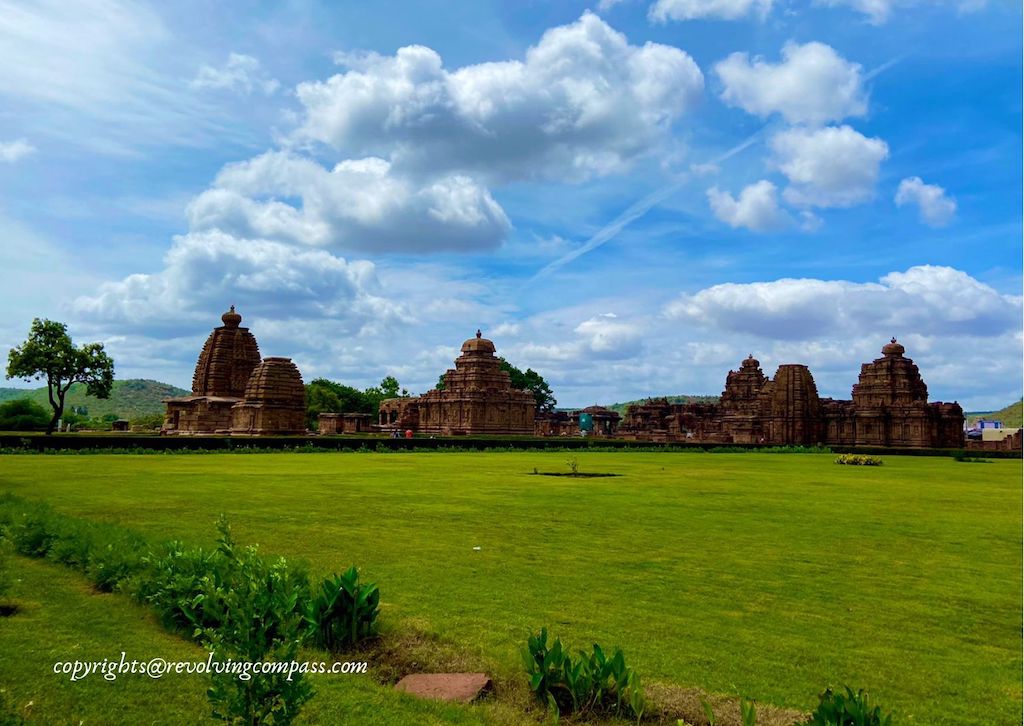
Although we have visited several ancient temples of India so far. Many of which have simply left us spell bound. I struggled to grasp the details in the Jain Temple of Ranakpur and the temple of Halebidu in Hoysala Kingdom. While I was left gasping looking at the carvings of the Temple Complex of Khajuraho on our trip to Madhya Pradesh. Equally impressive was Brihadeeshwara temple – the temple that doesn’t cast a shadow. And so many others.
But years after visiting these temples, finally materialised my trip to the trip of Badami – Pattadakal – Aihole – the circuit that is of utmost importance to the temple architecture of India. Wondering why? Read on:
Aihole – Is the place where the temple prototypes were developed, artisans practiced for years and refined their skills. It is called the cradle of temple architecture of India.
PS : Exploring the cradle of Indian Temple Architecture at Aihole
Badami – Is where after training from Aihole, the artists built temples and further refined their skills. It is called the school of temple architecture in India.
PS: Places to see in Badami in a day
Pattadakal – Is where the trained and skilled artists used their skills to develop full temples with mind blowing architecture. It is called the university of temple architecture in India.
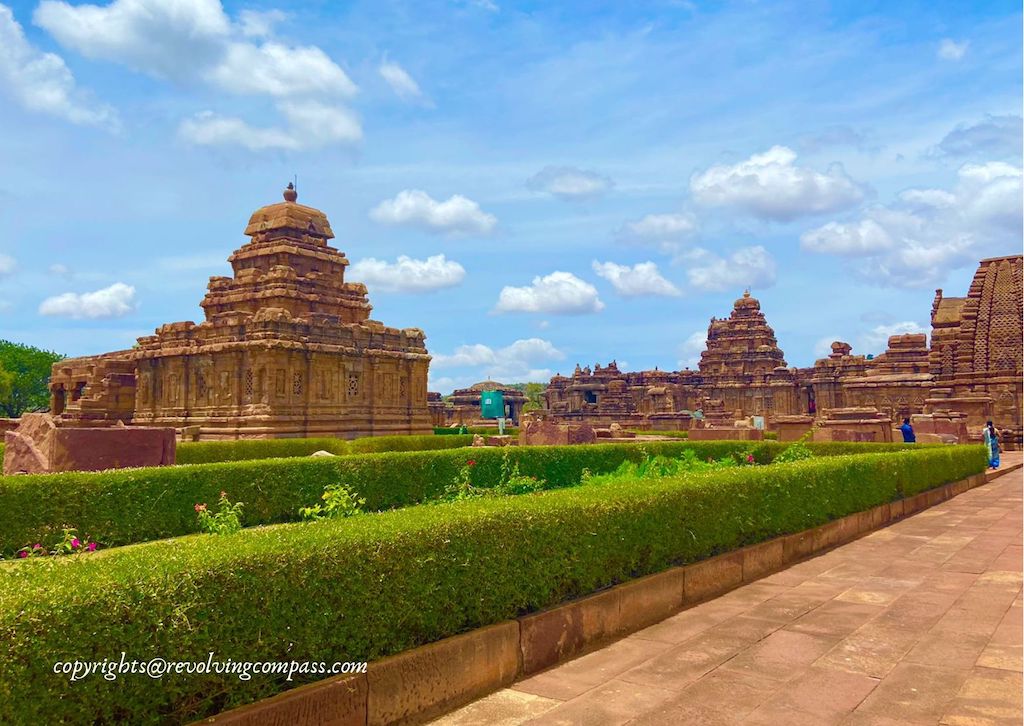
Aihole and Pattadakal are also the only temple complexes in India where one can see different temple architecture from across the country under one single complex. These include –
- Nagara Temple Architecture of North India which is evident in the temples of North India including the Kashi Vishwanath Temple of Varanasi, the Khajuraho Group of Temples in Madhya Pradesh, Sun Temple in Konark, the Sun Temple in Modhera, Gujarat, and the Ossian Temple in Gujarat.
- Dravidian Temple Architecture which is evident in most of the temples of South India including the famous Big Temple or Brihadeeshwara Temple of Thanjavur, The temples of Kolar and Avani, Meenakshi Temple of Madurai, Veerupaksha Temple of Hampi and the Hoysaleshwara Temple of Halebidu to name a few.
- Mixed or Hybrid temple architecture that includes both South and North Indian Temple Architecture elements.
- Jain Temples
The different types of temples in Pattadakal and their versatile architecture as well as their intricate carvings that have so much details just blew my mind away!!
Table of Contents
History of Pattadakal – why is Pattadakal famous?
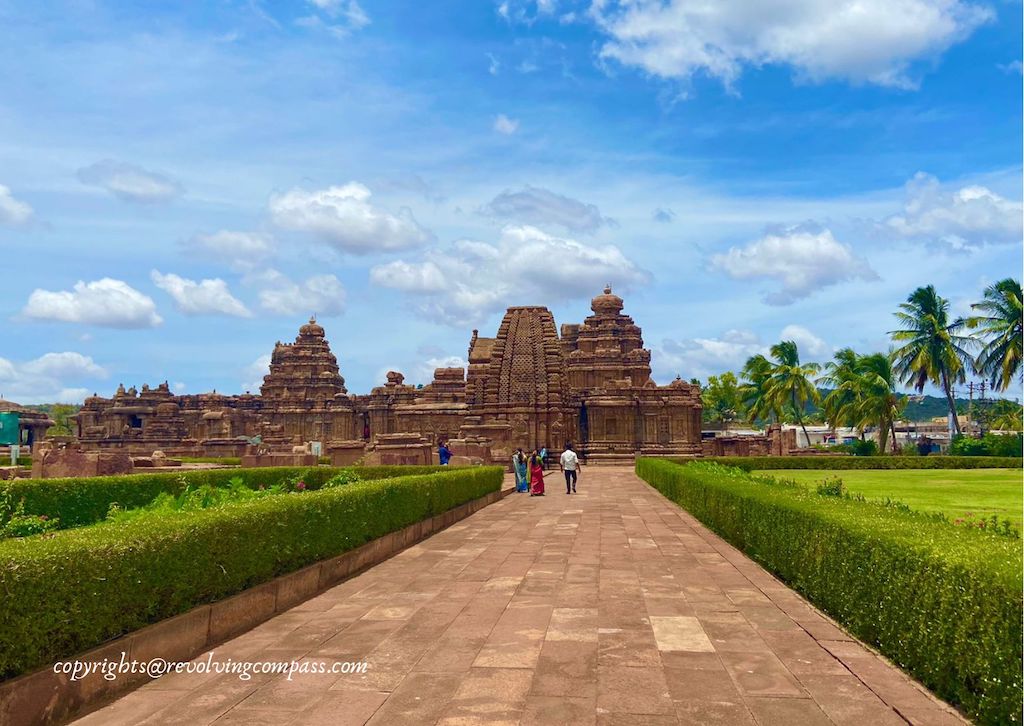
Unique red sandstone hills surround the region of Badami – Pattadakal – Aihole. And it lies in the valley of the Malaprabha River. Making it a perfect place for human settlement. And also a strategically perfect place because it was so difficult for outsiders to attack such a uniquely protected area. There has been evidences of human life in this region that goes as far back as the iron age. Over centuries, different dynasties ruled this region. With the Chalukyas Dynasty and the Vijayanagara Empire being the most prominent ones. During their rule, the region thrived. And that is when art and architecture were given utmost importance.
Different kings of the Chalukya dynasty and Vijayanagara Empire over the years provided funding for building and development of major Hindu Temple architecture that then spread to the rest of the country. The artists were given resources and land for training their skills, refining them and then building temples in Pattadakal using their refined skills. Later on the region was attacked by the Delhi Sultunate. During that time, many of the temples were destroyed. People in Pattadakal covered the temples with mountains of stone in order to protect them. As a result, you will some of the huge temples in the complex completely saved and still intact. Later Tipu Sultan ruled the region, until his death.
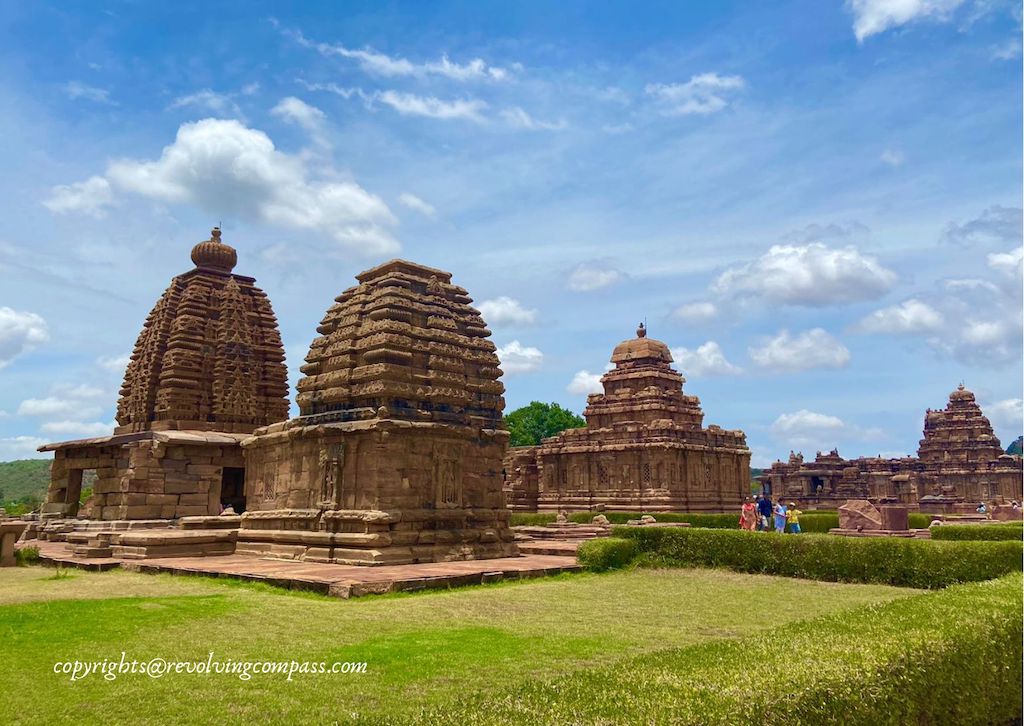
The monuments of Pattadakal are protected by the archeological survey of India (ASI) . And they are also one of the many UNESCO World Heritage Sites in India. With Hampi being the other UNESCO world heritage site, just couple of hours away.
Different interesting names with which the Pattadakal region is known
Just like it’s rich history, Pattadakal has several names. Or, I should say, it has been called by different names in different eras. Some of the names that have decorated the valley of Pattadakal include –
- Raktapura – which translates to land of blood – owing to the red soil and red sandstones that mostly cover the valley, Pattadakal was once called Raktpura
- Kisuvolal – which again translates to the meaning – valley of red soil.
- Pattadakal – which means coronation stone, as the coronation of royal kings during the rule of the Chalukya Empire took place here.
Resources from our Badami-Pattadakal-Aihole trip
A 4 days trip to Badami, Pattadakal and Aihole
The cradle of ancient temple architecture in India at Aihole
The Bhootnath Group of temples at Badami
If you are an enthusiast of ancient architectures, rustic places and lost cities as my kid fondly calls them – then this circuit is a must visit place for you! Also, it’s a pride heritage of India.
Reaching the Pattadakal Group of Monuments in Karnataka
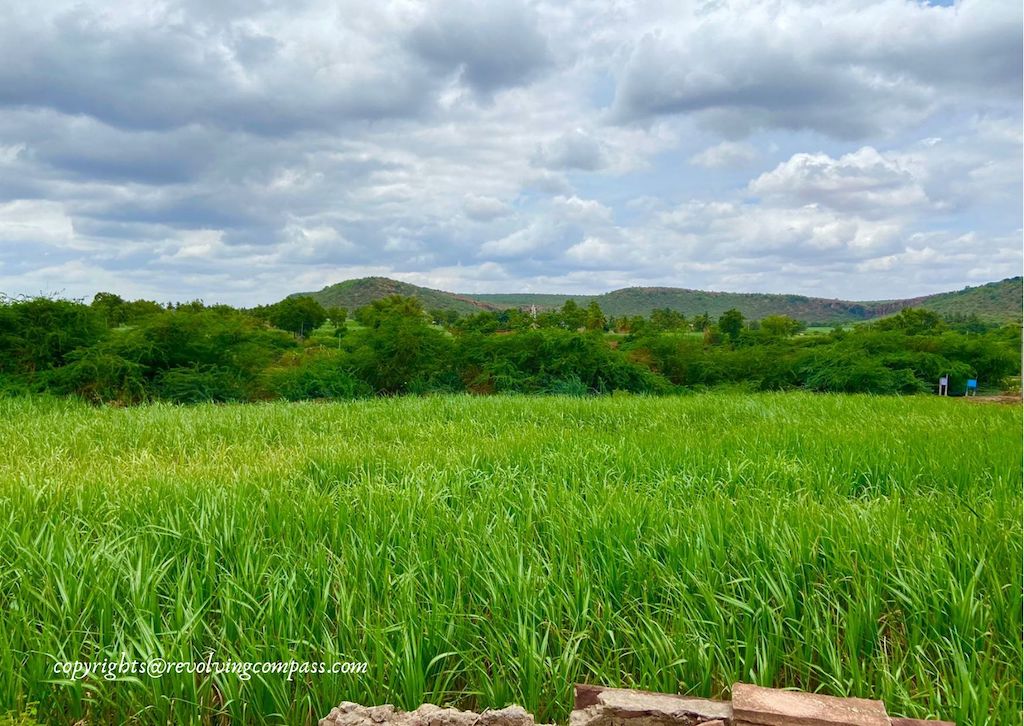
Pattadakal is a small village at the outskirts of current town Badami in the Bagalkot district of North Karnataka. With hardly any stay options and not many food options. So, it’s best visited along with Badami. One can conveniently stay in Badami. And take a road trip from Badami to Pattadakal. The road connecting Badami to Pattadakal is in excellent condition. And one can navigate it in the following ways :
- Self drive from Badami to Pattadakal & Aihole
- Take a taxi from Badami to Pattadakal & Aihole
- Take a bus from Badami to Pattadakal & Aihole
- Book a local auto from Badami to Pattadakal
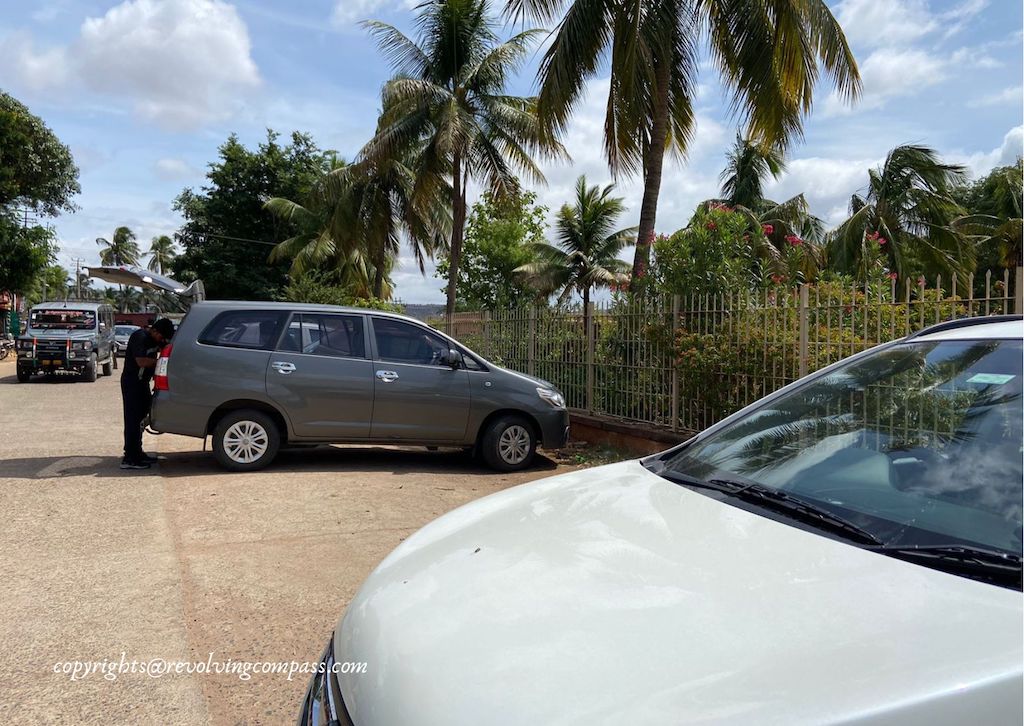
We drove to Pattadakal from Badami. And visited here along with Aihole. It was a day trip from Badami to Pattadakal and Aihole along with Banashankari Temple. While we stayed overnight at Badami. If you want to know how we planned this trip, here’s a complete detail on planning a trip to Badami, Pattadakal and Aihole.
Badami is the nearest train station, located some 22 km from Pattadakal. Often people drive to Badami or take an overnight train from other parts of Karnataka and neighbouring states to Badami. While, Belgaum will be the nearest airport, Hubli is the second nearest.
Map of the Temple complex at Pattadakal group of monuments
The temple complex at Pattadakal group of monuments in Karnataka is beautiful. You can site 10 major temples in the temples in Pattadakal – 9 Hindu Temples dedicated to Lord Shiva and 1 Jain Temple. Interestingly, half of the Hindu Temples are in the “Nagara” style of architecture followed in North India. While the other half are in “Dravidian” style of architecture followed in South India. You should put an order to visiting these temples to make things easier. As you will already be overwhelmed by their architectural details. And the way they are all over in the complex. So, here’s how we went about these temples :
- Kadasiddeshwara Temple
- Jambhulingeshwara Temple
- Sri Galaganaatha Gudi
- Sri Chandrashekhara Gudi
- Sri Virupaksha Temple
- Sri Papanaatha Gudi
- Papanatha Temple
- Sri Kashi Vishweshwara Gudi Kashi Vishwanath Temple
- Sri Jaina Narayana Temple
- Mallikarjuna Temple (not shown on the map) but located right besides the Virupaksha Temple
Let me now take you on a virtual tour through these temples of Pattadakal one by one.
If you are wondering how to recognise which temples are in Dravidian Style vs which are in Nagara Style, here’s a short description of each of these styles of architecture –
Nagara Style of Temple Architecture
The Nagara style of temple architecture is a prominent style of North Indian temples which has the following main features –
- Entire temple is on a raised platform with staircases leading to the temple shrine
- There is a flat structure in the front and a tall tower towards the back
- The “Garbhagrih” or main sanctum of the temple is often right below the tall tower at the back.
- Often in larger temples, there is an outer chamber outside the Garbhagrih, and a “verandah” outside of it, where one steps after climbing the stairs.
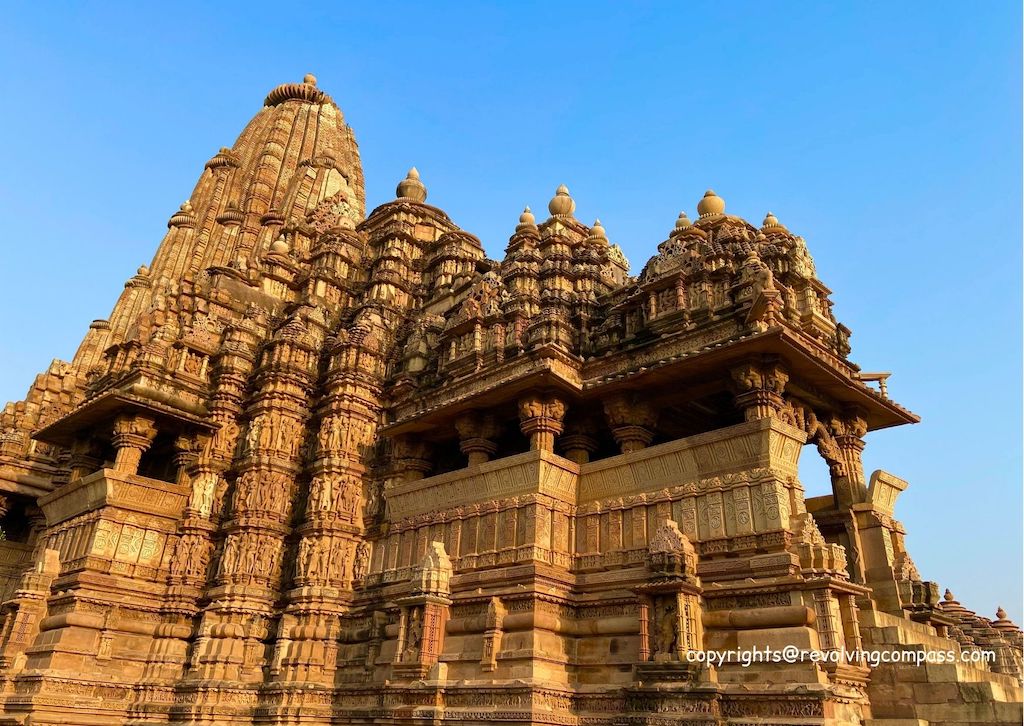
Dravidian Style of Temple Architecture
The Dravidian Style of temple architecture is a prominent south Indian style of architecture. It’s is characteristics are –
- Very intricate carvings on the walls and shikhar of the temple, depicting mythology, purana, epic stories like those from Mahabharta and Ramayana as well as animal figures and Gods.
- Dravidian style temples are enclosed inside an outer wall.
- The “Shikhar” of the temple rises up in distinct steps than like a dome.
- Often there is a water body or a temple tank besides the temple.
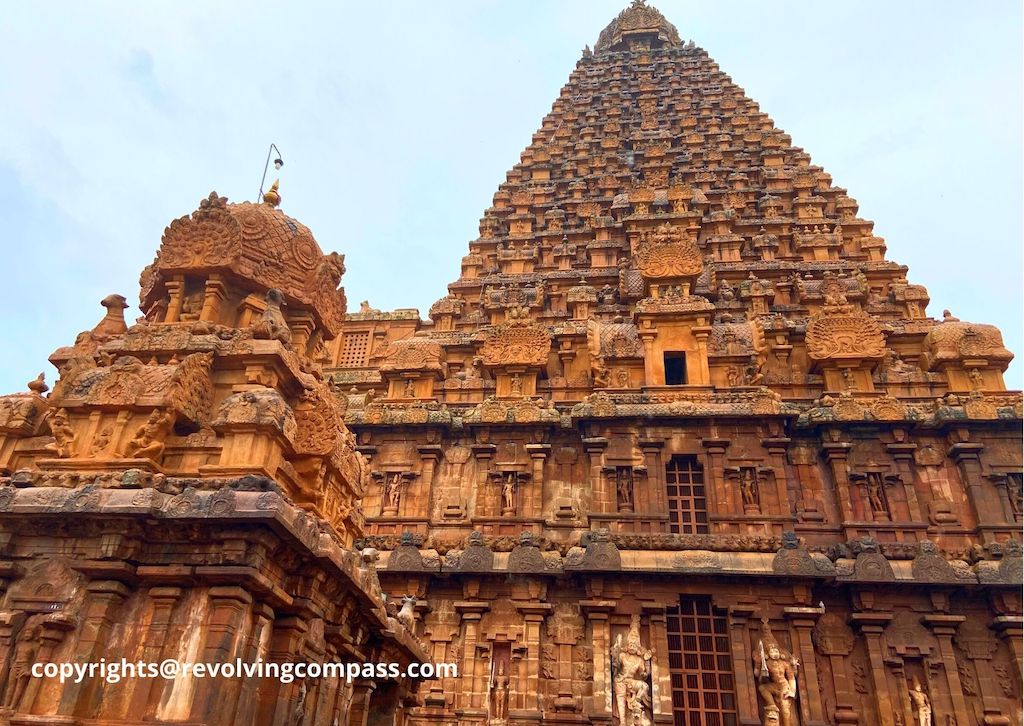
Virtual Tour of the Pattadakal Temple Complex
Let’s now start a tour of the temples at Pattadakal Temple Complex.
We started from our hotel in Badami, Heritage Resort Badami, post breakfast around 10:30am. And it took us around 30 minutes to reach the Pattadakal group of monuments. It’s a straight two lane road from Badami to Pattadakal with beautiful views of the valley and the sandstone hills beyond it. Upon reaching, we parked our vehicle outside the monument complex. And entered inside the gate. To the left of the main entry gate is the ticket counter as well as restroom facility. After taking the tickets, we proceeded inside the complex.
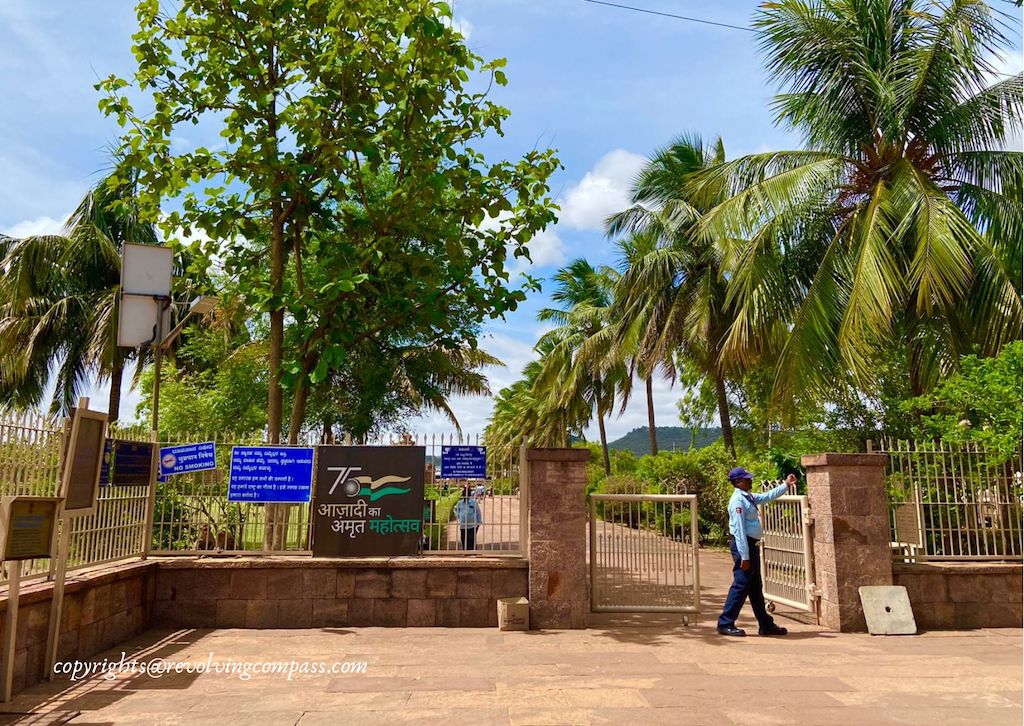
Entry ticket for Pattadakal Group of Monuments : Rs 40 per adult
There is no entry fee for kids less than 12 years of age.
Inside the Pattadakal Temple Complex, there are 5 designated guides. We hired one for our tour through the complex. It’s always good to hire a guide when visiting such rich historical places like the Pattadakal Temple Complex. Since there is so much to understand and learn. With the guide, we took a tour of the Pattadakal Temple Complex in the following order:
Kadasiddeshwara Temple
Architectural Style : Naggara
Kadasiddeshwara Temple is the first temple we stopped at. The main features of this temple include an Ardhanaarishwar ( A form that depicts half Parvati and half Shiva ), Harihara Sculpture, and three big carvings, one on each wall of the temple. Another prominent feature is the idols of Parvati and Shiva carved out on either side of the door and a “Swastik” window. The tall front and flatter back side of the temple reminded me of the architecture of some of the temples we visited on our trip to the Khajuraho Group of Temples.
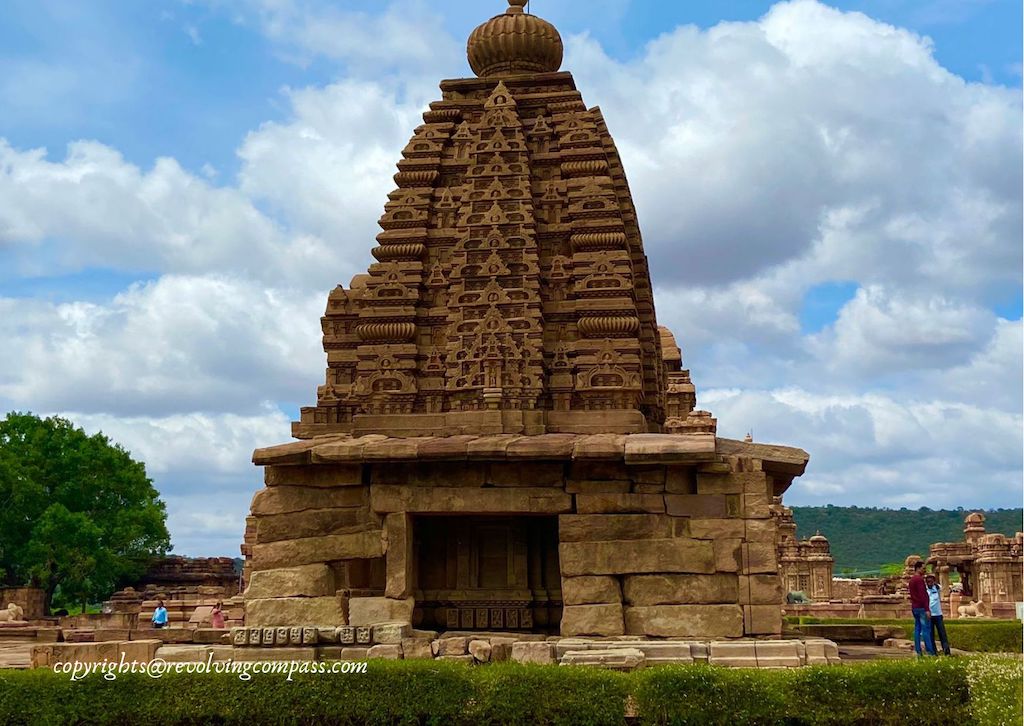
Jambhulingeshwara Temple
Architectural Style : Naggara
The next temple in the complex is the Jambhulingeshwara Temple of the Pattadakal Temple Complex. This temple is very similar to the earlier one in it’s construct, and a little larger. But the main feature of this one that stands out is the round shape in front of the dome with a Natraj (dancing form of Shiva) carved out in the center of the circle, along with Nandi and Parvati on it’s either side.
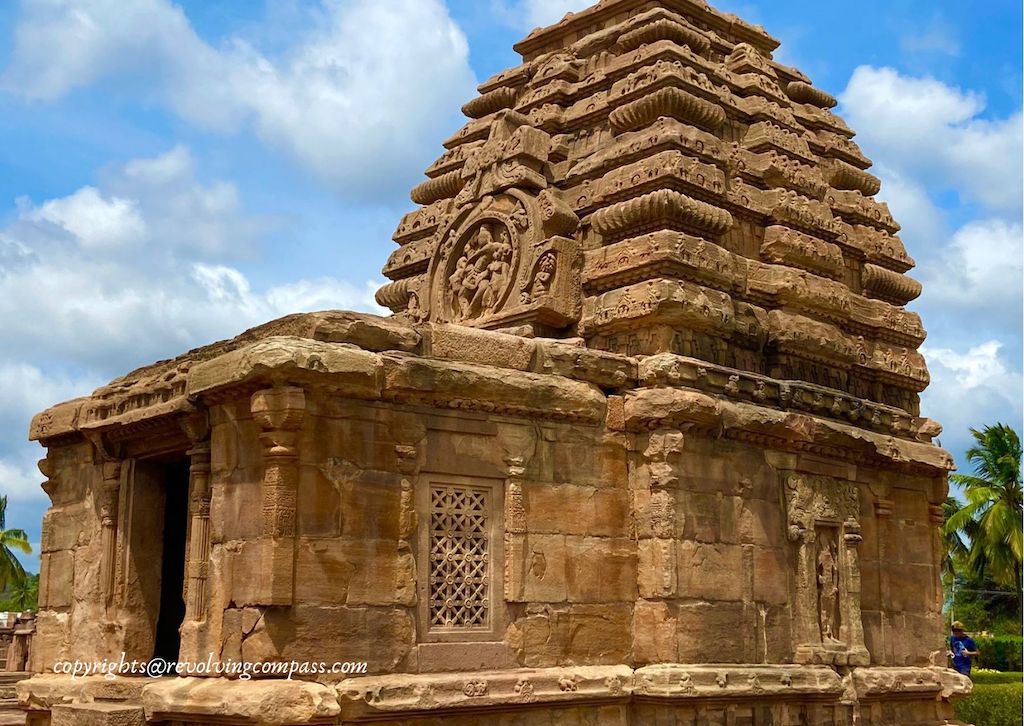
This temple not just have carvings, but they are actually “framed” inside outer borders. If you look closely, you will be able to see the carvings depicting several Hindu Gods including the Sun God (Surya), Vishu and other avatars of Shiva. There is a platform in front of the temple entrance, maybe for a Nandi, which is missing now. As, most of the other Shiva temples that we have visited, including the temples in Khajuraho, and Halebidu Temple, all have a Nandi on a platform outside the temple, facing the main shrine.
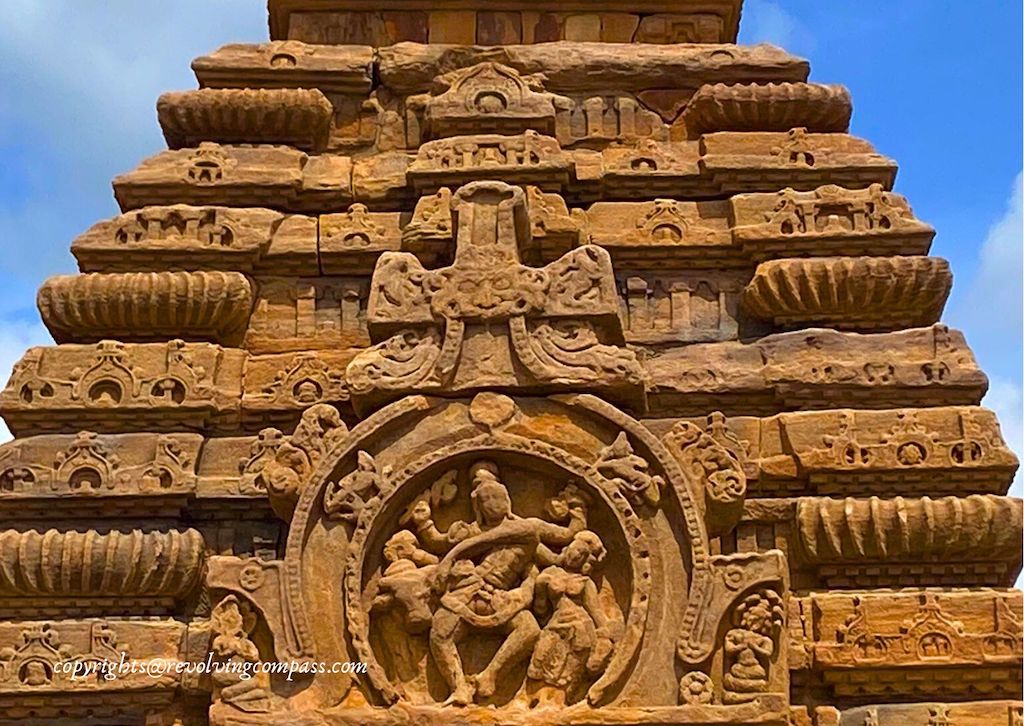
Sri Galaganaatha Gudi
Architectural Style : Naggara
As you move further exploring the Pattadakal Group of Monuments, you reach the Galagannatha Temple. This is one of the large temple that you witness in the Pattadakal Temple Complex. The temple has a passage separating an outer hall called Sabha Mandap and an inner hall called Mukha Mandap. The Mukha Mandap surrounds the innermost “Garbha Griha” or central sanctum where the idol stands. Exactly how each of the temples of Khajuraho are built.
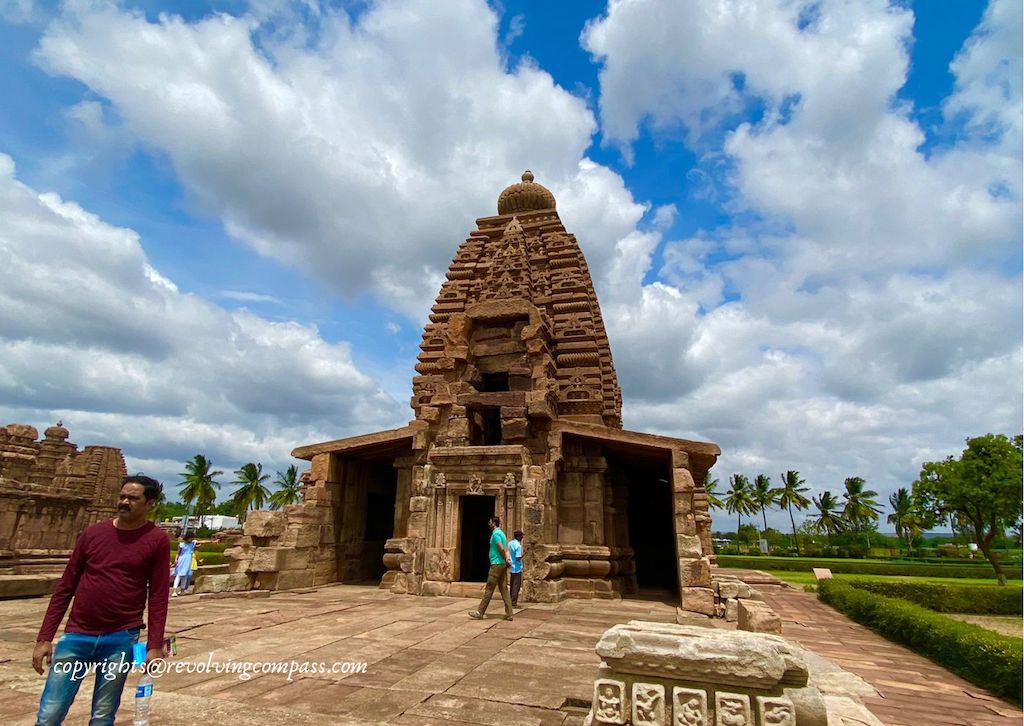
You can take a circle around through this chamber and come back to the main door. There are not many prominent carvings on the outer walls of this temple, many are ruined with time. But there is one noticable form of Shiva slaying the demon Andhaka. Our guide told us that in this form of temple architecture, the Mukha Mandap was where the royal families or the prominent and rice people offered their worship while the Sabha Mandap was the one where the general public offered their prayers to the God.
Sri Chandrashekhara Gudi
Yet anoher small temple right besides the Galagannatha Temple is the Chandrashekhara Temple. Unfortunately, this small temple is mostly in ruins now. One can easily miss this temple amongst the other much larger temples.
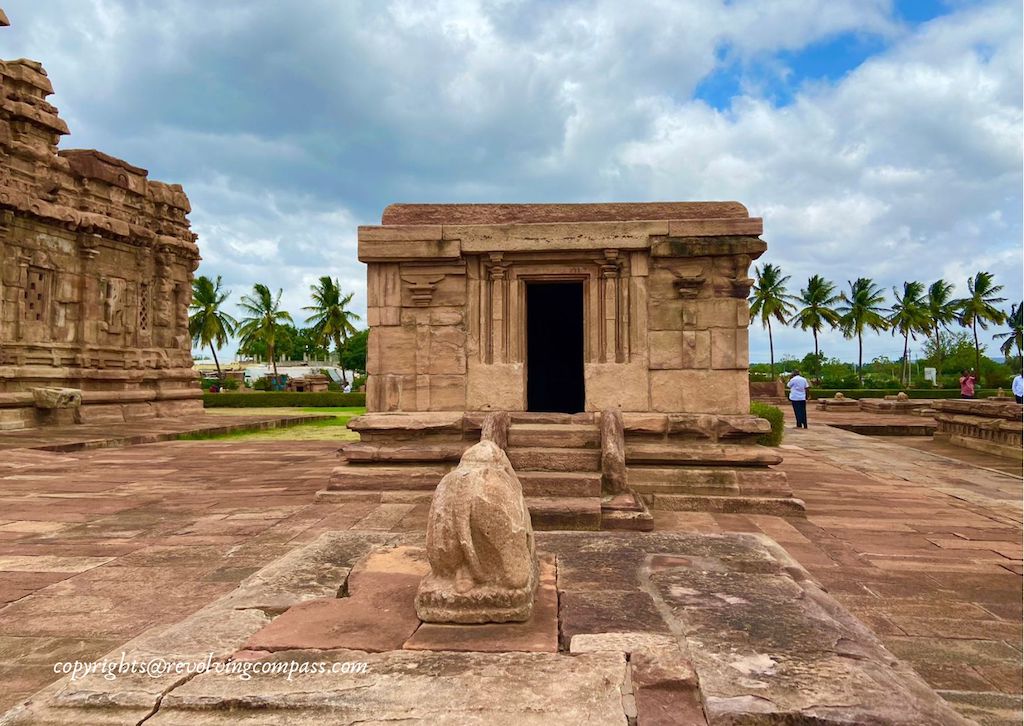
Sri Virupaksha Temple
Architectural Style : Dravidian
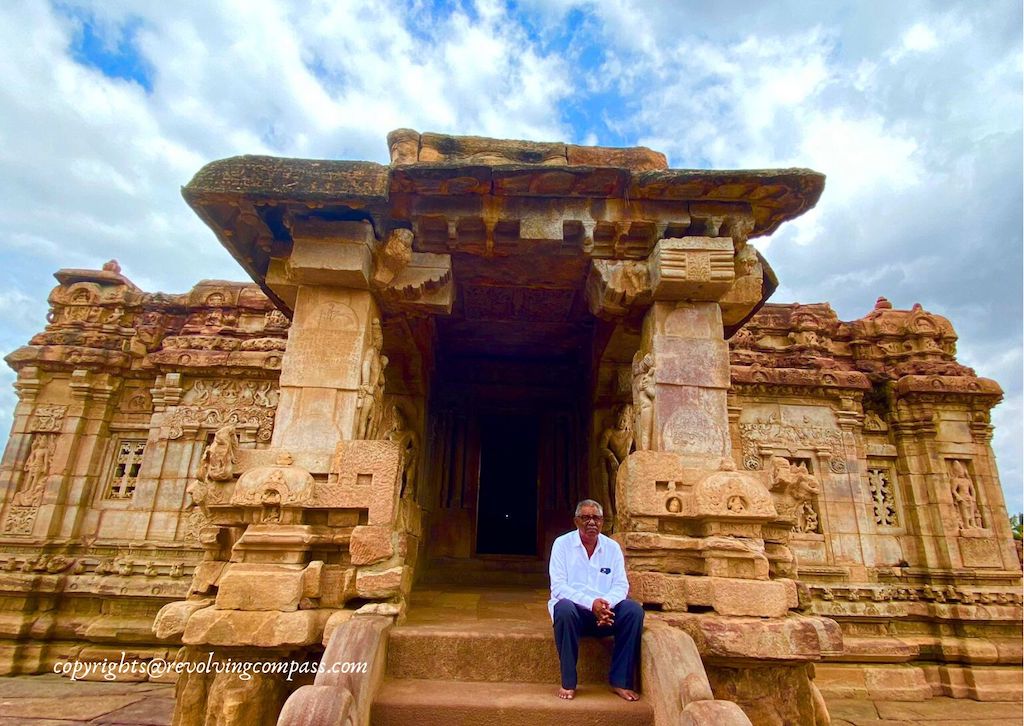
The largest and the most intricate of all the temples that you see in the Pattadakal group of monuments is the Virupaksha temple. It’s a Dravidian style temple. It has a temple roof of Vimana with a Kalash at the top. Through the walls and roofs of this temple you will see Hindu epic stories from Ramayana, Mahabharta, Puranas, Varaha Avatar, Narasimha Avatar, Harihara Avatar and several other avatars of the Gods Vishnu and Shiva. And interestingly even some erotic sculptures and some women sculptures that show women doing spa, carrying vanity bag, and having different hair styles !! Something that my guide particularly brought my attention towards 🙂
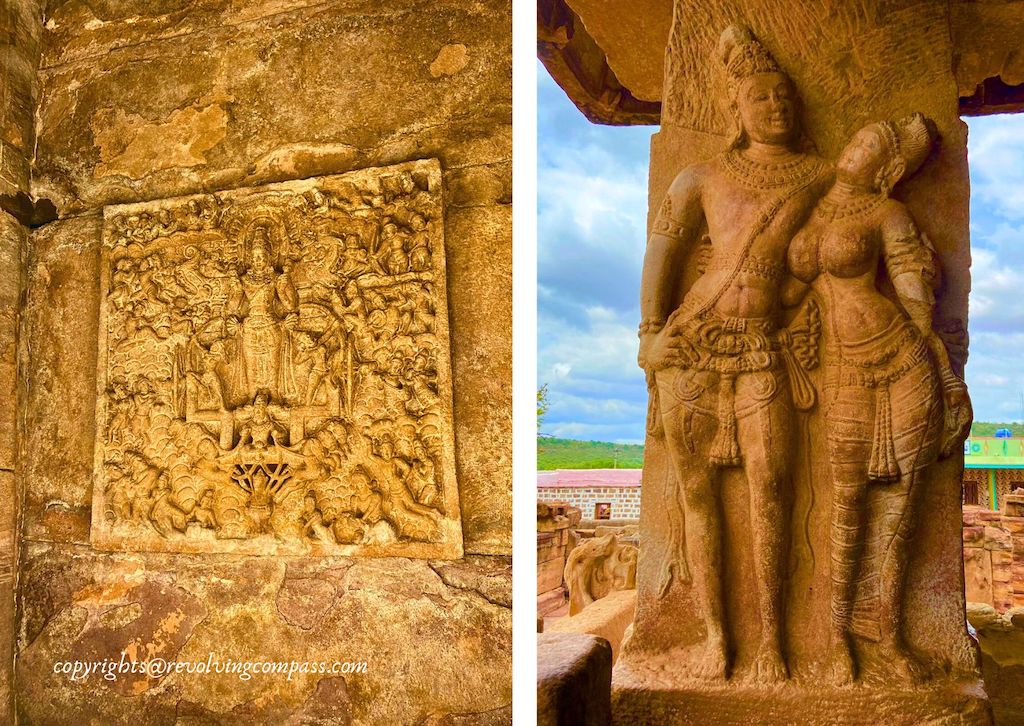
The Virupaksha Temple has 9 different distinct parts of a typical Dravidian style temple. The details in this temple were so overwhelming that I feel the need to dedicate a post towards it. And I will do that soon. It has a big monolith Nandi facing the temple, sitting in it’s own small chamber. And inside the main temple, there are some 18-20 pillars. Queen Lokadevi, wife of King Vikramaditya is credited with the construction of this temple. As per the stories, she commissioned the construction of this temple to commemorate the victory of Vikramaditya over the Pallavas. This is a live temple. Where the worship of the Gods still happens on a daily basis. And hence there are strict requirements to leave your shoes behind while entering this temple.
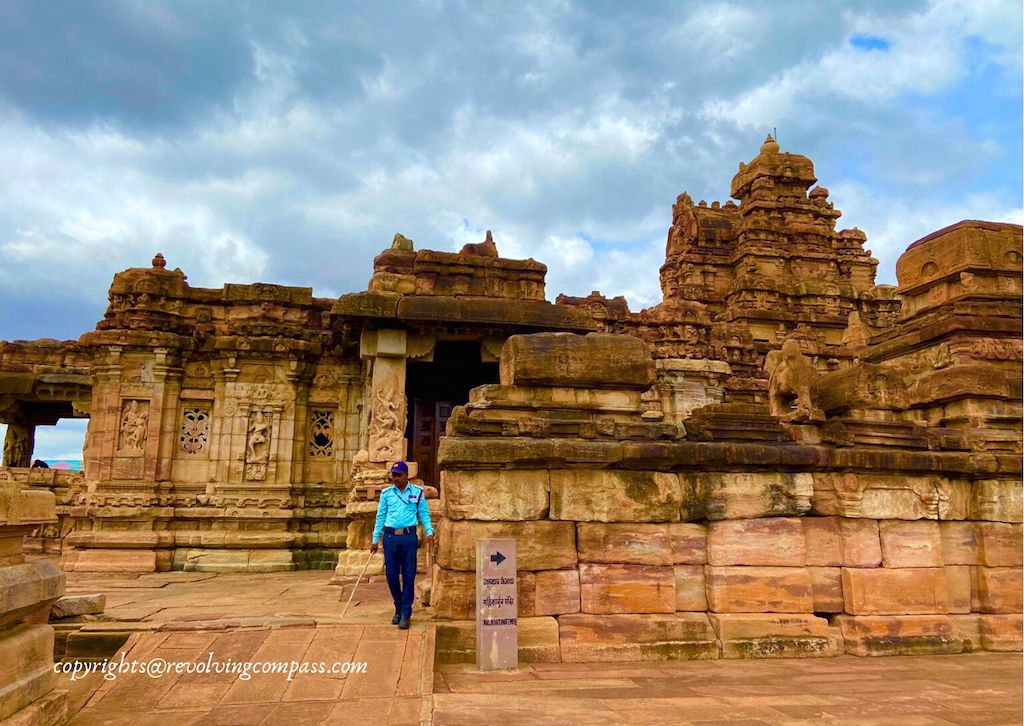
Mallikarjuna Temple
Architectural Style : Dravidian
Mallikarjuna Temple lies right besides Virupaksha Temple. And you are most likely to visit here after visiting Virupaksha Temple, as you start taking a circle back to the entry of the Pattadakal Group of Temples. It is also one of the largest temples in the complex. And more detailed in it’s construction, elaborate in it’s carvings compared to other temples. It has a nandi inside an enclosed chamber followed by a large Sabhamandapa. And then a large inner sanctum or Mukhamandapa. The main shire has a Shivalinga, and the two adjacent shires also had some idol at some point of time. But they are missing now. In this temple, you will see mythological stories carved out on the pillars. The second queen – Trilokyamahadevi of king Vikramaditya made this temple.
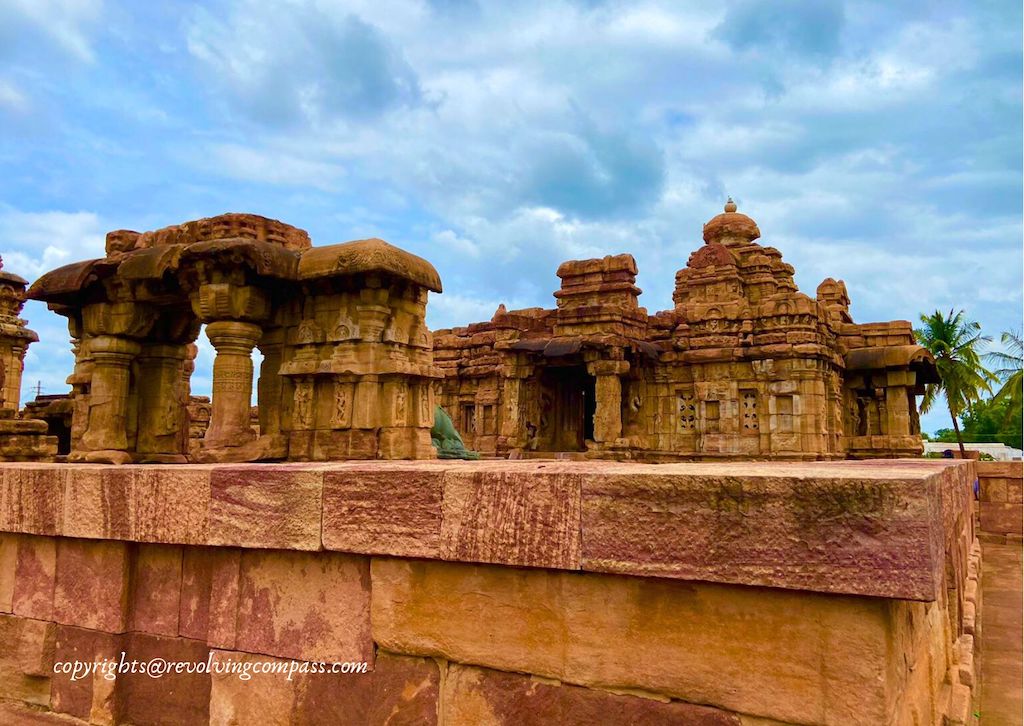
In fact, our guide told us that Queen Lokadevi and Trilokyamahadevi were sisters, perhaps twins. So, while each one of them commissioned the construction of the Virupaksha and the Mallikarjuna Temple, no wonder the two temple architectures compete in terms of their grandeur.
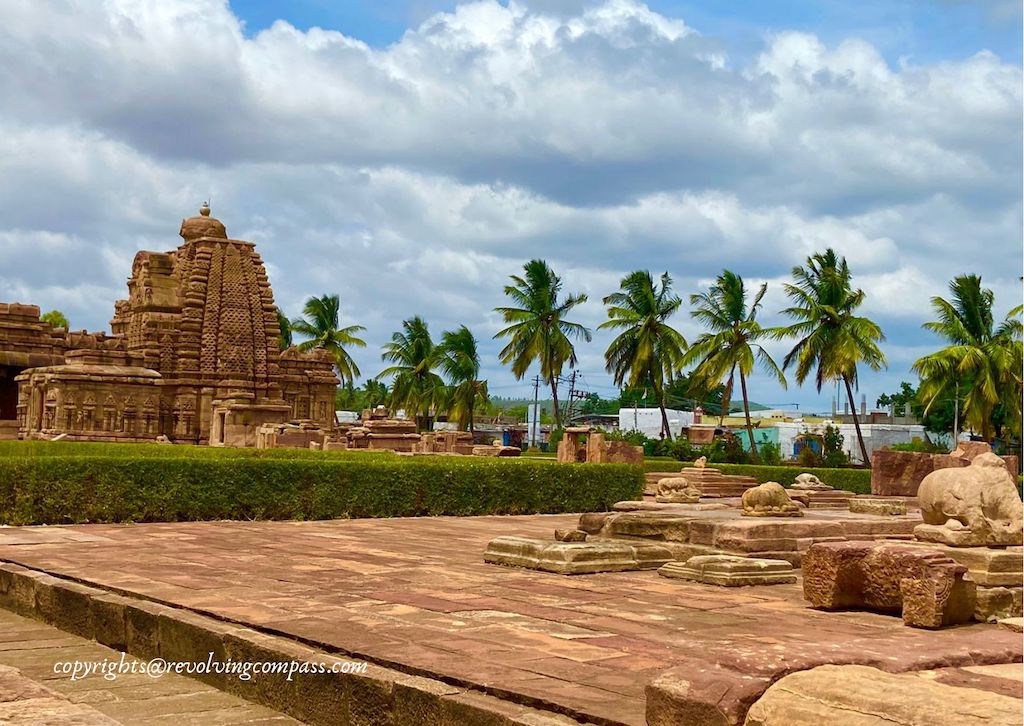
Sangameshwara Temple
Architectural Style : Dravidian
Next in the Pattadakal archeological complex came Sangameshwara Temple. Again, the temple is huge and elaborate. The front platform has a statue of Nandi facing the main temple. Followed by a passageway that connects to the inner sanctum. Also, there is a well lit path to go in circle around the main Shivalinga inside the inner chamber of the temple. Then around the main shrine, there are small shrines in all directions of other important Hindu Gods and Goddess including one dedicated to Ganesha and one to the Goddess Durga.
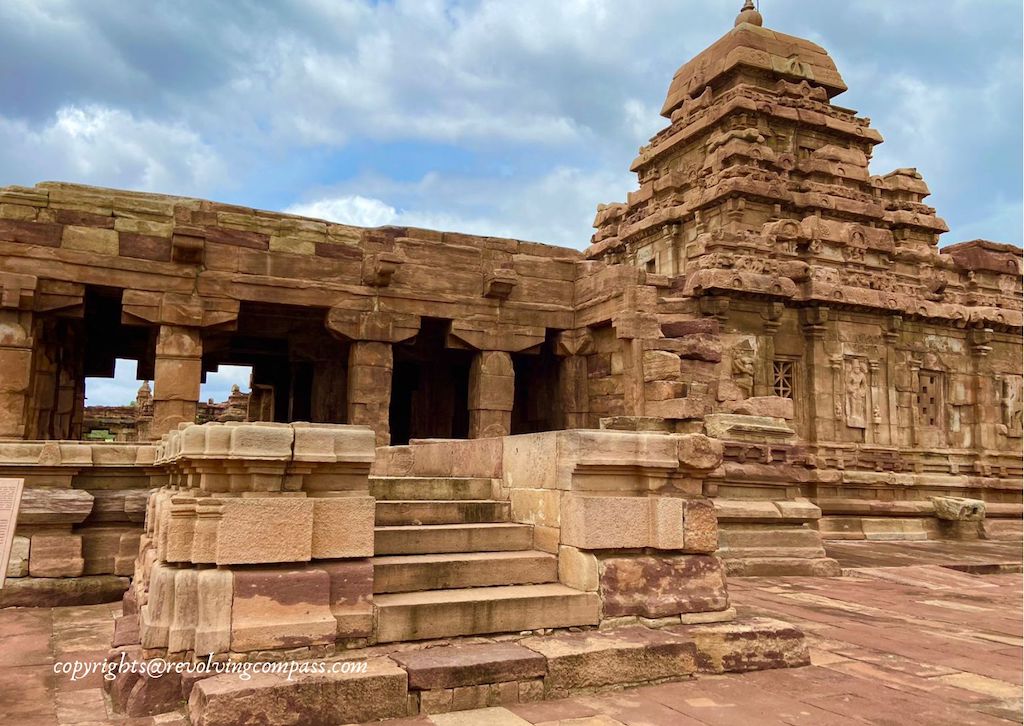
On the outer walls of the temple, you will witness several flower carvings, Ganas. The carvings here can be related to those on the temples in the caves of Badami. Thus, this temple could have been a prototype for the actual temples of Badami Caves. Although the temple seems complete, its believed that when its patron , King Vijayaditya died, it was left as is post that. The inscription on the wall of the temple dates it to 720 CE!! This is the oldest temple in the Pattadakal group of monuments.
Sri Kashi Vishweshwara Gudi or Kashi Vishwanath Temple
Architectural Style : Nagara
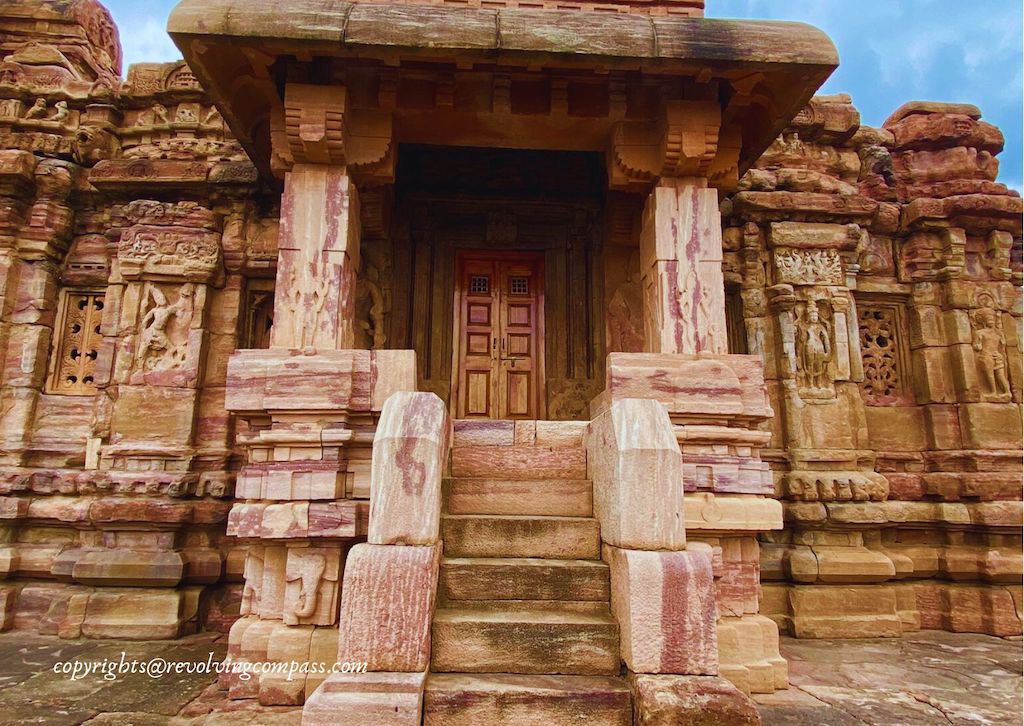
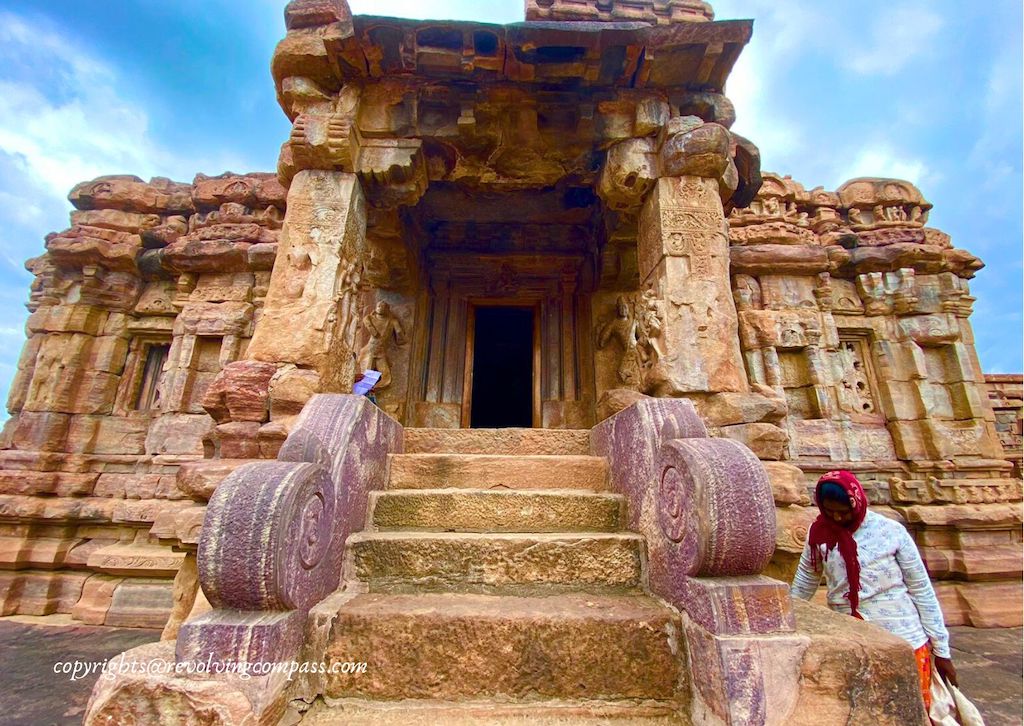
Another beautiful North Indian style temple, Sri Kashi Vishwanatha temple is the next on our list. The name of the Kashi Vishwanatha temple suggest that some of it’s carvings and structure might have been prototype to the main Kashi Vishwanath Temple in Varanasi that I am yet to visit. Let me know if you can confirm the same. again, this is a very large temple. The layout of this temple is very similar to other temples in the complex. With the standard outer chamber , inner chamber and the final inner shrine. This temple has very intricate carvings. That include stories from mythology, from the Hindu epics like Mahabharata and Ramayana, depiction of Shiva and his family , Shiva Purana scenes, intricate floral carvings and several animal forms.
Sri Papanaatha Gudi – set aside from rest of the temples at Pattadakal
Architectural Style : Hybrid of North and South Indian styles of architecture
After visiting the temples in the Pattadakal Temple Complex, we headed towards the bank of the river Malaprabha. A path in front of the Virupaksha Temple leads outside the complex. In the front, a flight of stairs and then a kaccha road lead to the banks of the Malaprabha River. While towards the right, almost 300 meters lies the Papannatha Gudi. This is one of the unique temples. Because it has an infusion of both North Indian and South Indian style of temples. The towers and roof of the temple depict the Nagara style and the carvings on the inner walls depict the intricate Dravidian style of architecture.
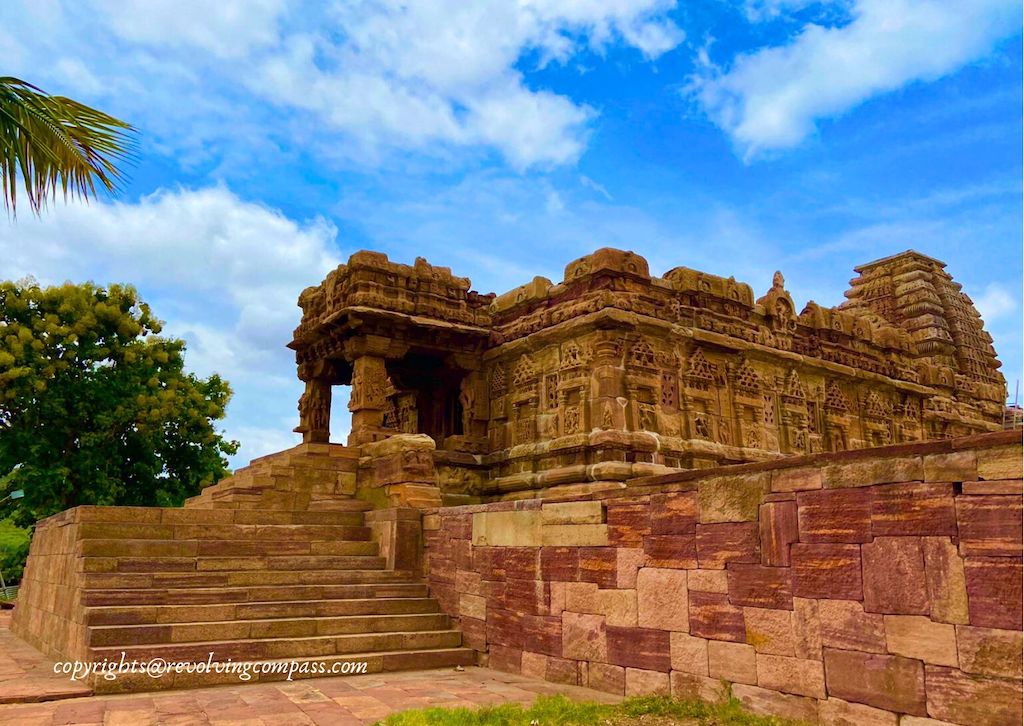
While my family took rest near the stairs of the main Pattadakal group of temples, I took a quick walk to Sri Papanatha Gudi. And I am really happy I did so. As I saw the unique hybrid combination of architectural styles. The only thing I couldn’t understand is why this temple is not a part of main complex of the Pattadakal Group of Monuments. If you know, do let me know as well.
Sri Jaina Narayana Temple – the Jain Temple of Pattadakal Group of Monuments
The only Jain temple in the Pattakal group of monuments is the Jaina Narayana Temple. It stands a little far from the other temples clustered together. This is also newer addition compared to other temples, in around 9th century by the Rashtrakutas. Just like most other Jain Temples, this temple is very simple. But very large. Inside is the Tirthankara. And as you step inside, it’s very peaceful and calm. This was the last temple that we visited in the Pattadakal group of Monuments. It took us around 2 hours to visit all these temples together.
The guide was with us for the first one hour. And then we explored around on our own.
Some Random Temples & Artifacts at the Pattadakal Group of Monuments
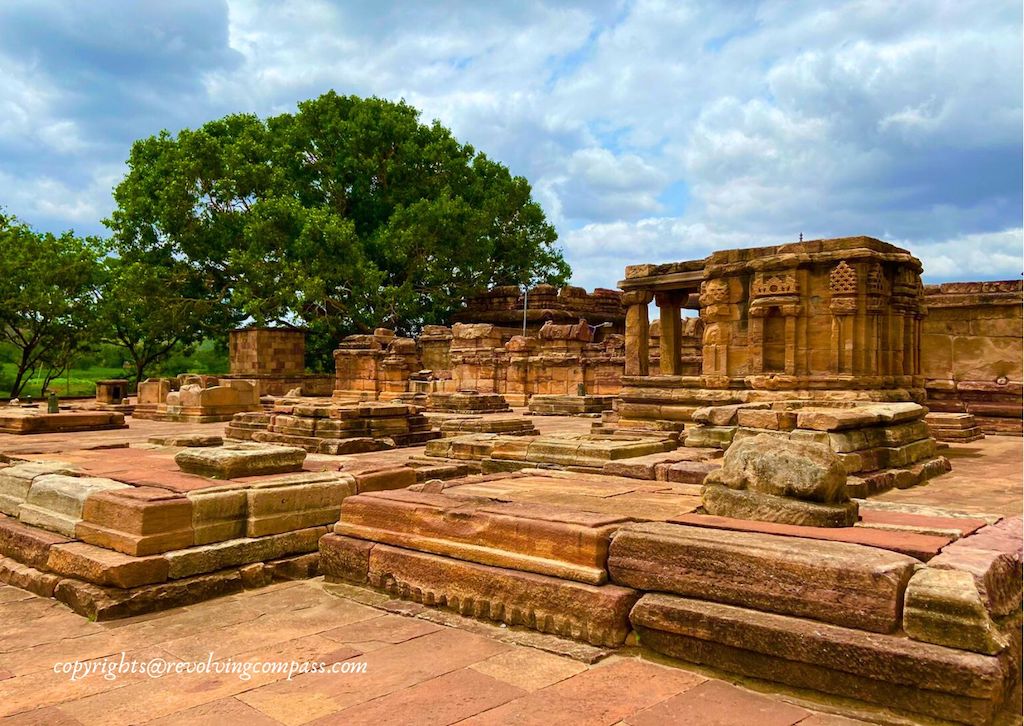
You will still see some incomplete temples and some small prototype of temples at the Pattadakal Temple Complex. Our guide told that these were developed to first get the king’s approval on the design. And then the actual temple complex was developed.
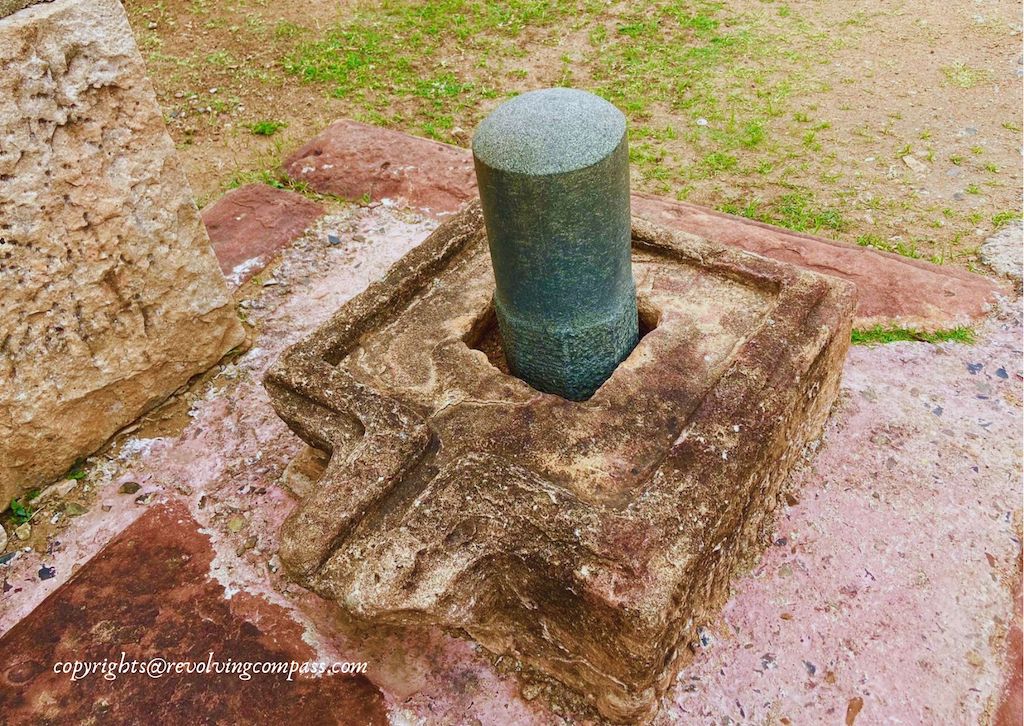
A free standing Shivlinga. Our guide told that this was the time, this form of linga took shape here at Pattadakal. It is surrounded by square platform, with provision for water or milk to flow out.
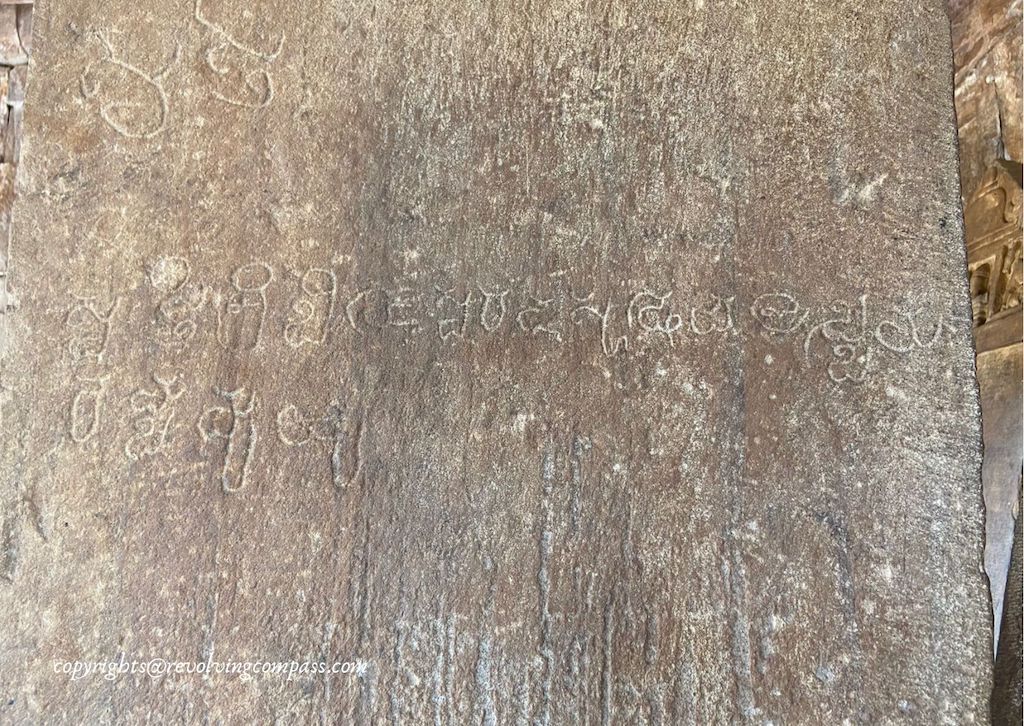
Upon close observations, you will find very fine inscriptions on the walls and pillars of the temples amongst the Pattadakal Group of Monuments. Upon close observation, you will see that these are written in the “old kannada” language. And often attribute the construction to the people who commissioned the money for the temples. The scripts also contain description of the temple itself.
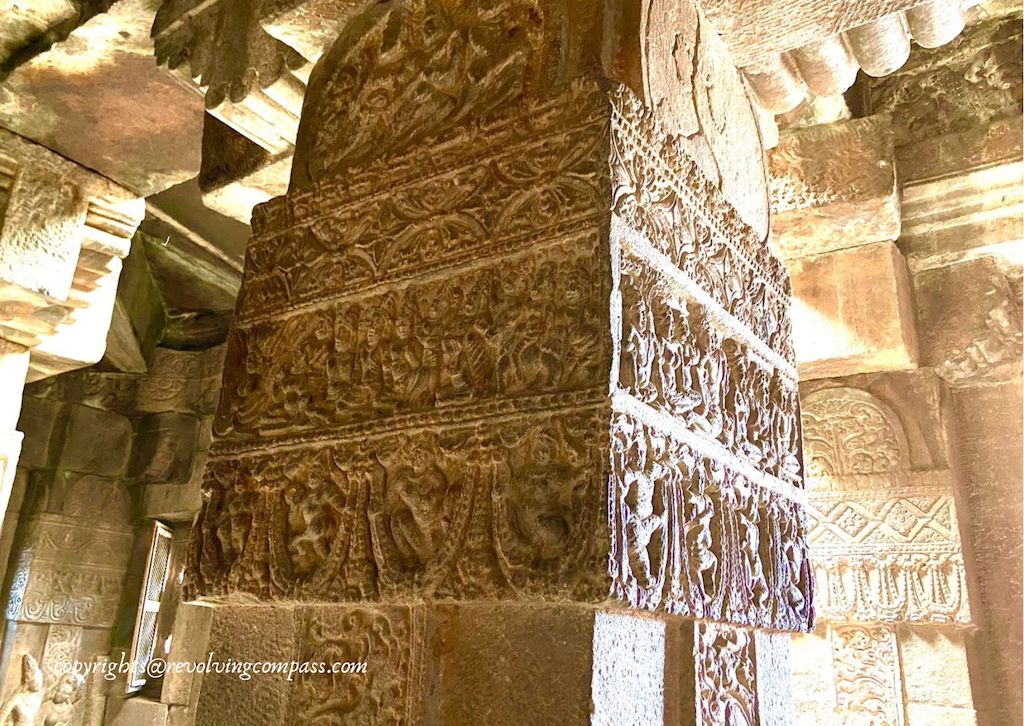
There are particularly intricate carvings on the walls and ceilings and pillars of Virupaksha Temple – a temple that wards a separate post of its own. And I will soon write that. These sculptures are very interesting. And have knowledgeable verses and stories narrated on them apart from the God figures.
Timings of the Pattadakal Group of Monuments
The Pattadakal Group of Monuments are open from 6:00am to 6:00pm on all days of the week. You can plan to reach here early to avoid crowd, as well as to avoid the mid day heat!
Best time to visit the Pattadakal Group of Monuments
Along with Badami and Aihole, the best time to visit Pattadakal is in the winter season from November till February. When the days are still hot. But the nights get very comfortable, with temperature hovering around 18-14 degrees. However, even the beginning of the monsoon season when the sky is overcast, make for a perfect time to visit the Pattadakal Group of Monuments. As, there is not much shade in the region. So, the clouds provide for the much needed shade. So, it’s a bit risky. If you are able to catch a cloudy but not rainy day, your visit to Pattadakal will be just perfect like our visit to the Chitradurga Fort.
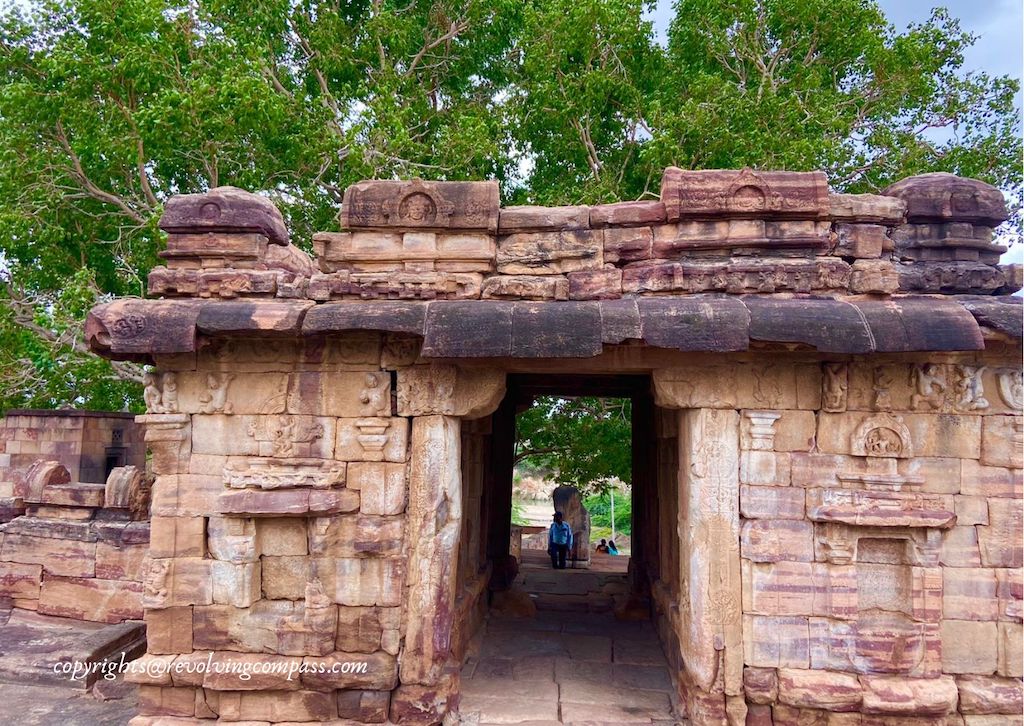
We visited here during the starting of the monsoons. When the cloudy days had started. But still the rains were not very heavy. So, overall it was hot and humid at times. And very comfortable most parts with cold wind blowing all the time. Visiting in off season always gives you the advantage of less crowd and lowered rates at accommodations. As long as you time it right. In fact, we booked our accommodation in Badami just 2 days before our trip. And yet we were able to grab a good deal.
Where to stay near the Pattadakal Group of Temples
You can stay in Badami and conveniently visit the Pattadakal Group of Monuments as they are just located some 22km from Badami. Aihole It takes half an hour to reach Pattadakal from Badami. Or, you can also stay at Hampi and do a trip to Pattadakal and Aihole from there. It takes around 3 hours drive to reach Pattadakal from Hampi. Here’s a list of hotels at Badami to explore. We stayed at the Badami Court Hotel and our stay was ok ok. If you prefer more comfortable or luxurious stays, then head to Hampi.
There are several homestays as well as luxury resorts around the town of Hampi and Hospete. You can browse the list here. On our first trip to Hampi, we stayed at Royal Orchid Hampi. And had a great time. And this time around we stayed at Arjun Homestay – a very comfortable stay again.
Another option will be to stay at Hubli. It is around 3 hours drive from Hubli to Pattadakal. But, doing a day trip covering both Pattadakal and Aihole will be difficult from Hubli. We have stayed earlier in Hubli on our drive to Goa for a Goa Workcation couple of years back. And some of the hotels we prefer to stay at when halting in Hubli are – (1) Hotel Naveen Lakeside (2) Presidency Hotel Hubli
General tips on visiting the Pattadakal Group of Monuments
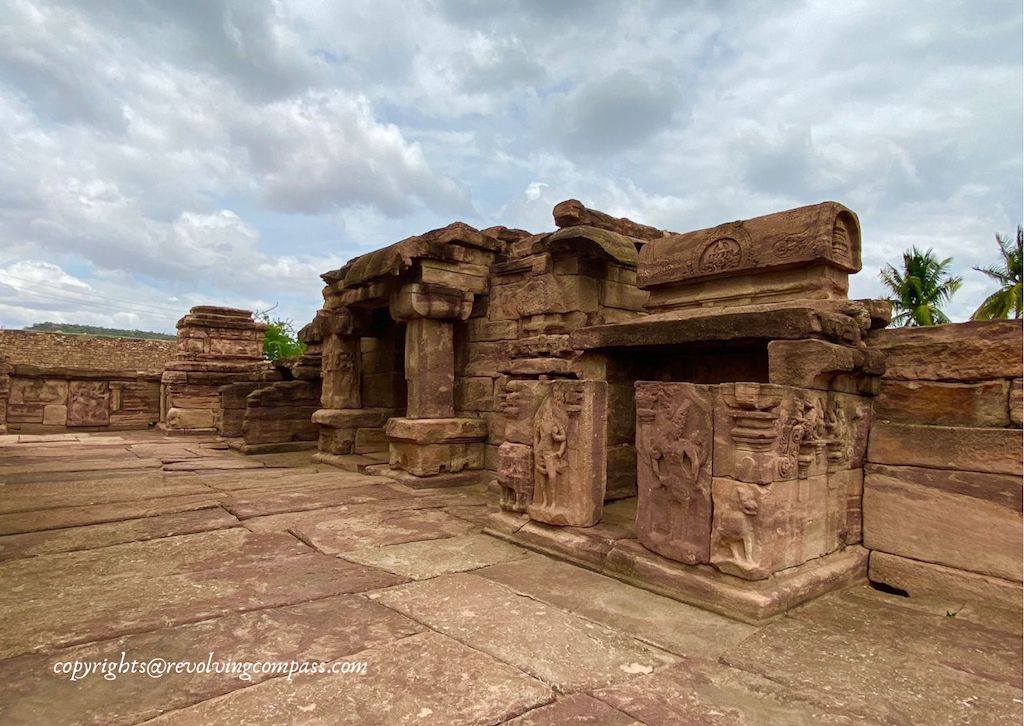
- Wear comfortable cotton cloths and comfortable walking shoes.
- Carry bottles of water with you.
- There are not many food options here except for some local food joints outside the Pattadakal temple complex. But if you are picky about what to eat, best will be to pack your lunch and carry with you when you visit here. I did the same for my family. As, my younger kid has limited food options and her stomach is also super sensitive.
- Allocate a minimum of 2 hours and a maximum of 4 hours to thoroughly visit the temple complex at the Pattadakal Group of Monuments. Do not make the mistake of cramming a tour of Pattadakal, Aihole and Badami in one single day ! You will end up overwhelmed. And not being able to visit any of these properly. I am still not able to understand how people do a day trip to Aihole-Pattadakal-Badami circuit from Hampi and come back within a single day!
- Book your accommodating in Badami in advance.
- There is a restroom available in the Pattadakal Temple Complex. However, don’t expect it to be super clean. We always carry these sanitary sprays with us, on such day trips.
PS: Some of our links are affiliated, this means we will earn a commission when you buy a service or product by clicking those links. However, this will have no extra cost for you.